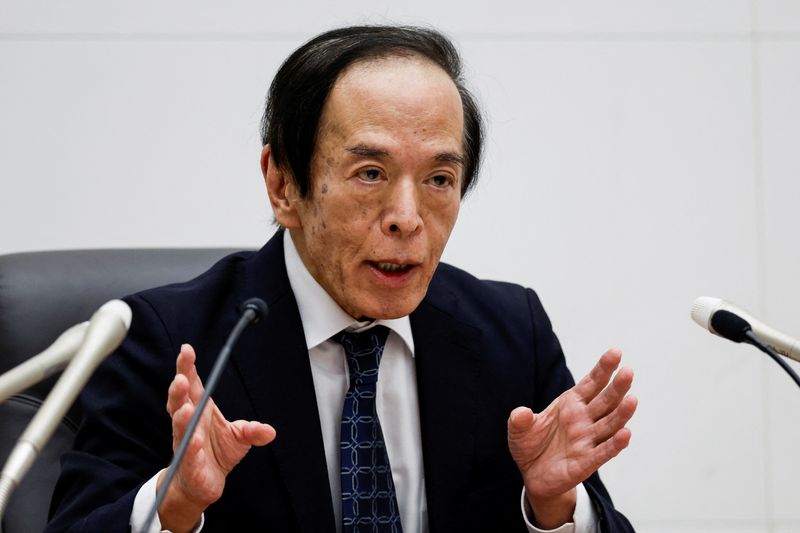
Written by Laika Kihara
(Reuters) – The Bank of Japan concludes its first monetary policy meeting of the year on Friday, with the result announced days after the inauguration of US President Donald Trump.
Here's a guide on what to expect and why the Bank of Japan's interest rate review is important:
When will the Bank of Japan meeting be held?
The Bank of Japan's board of directors, which sets monetary policy, holds a two-day meeting that concludes on Friday. It will announce its decisions at the end of its deliberations.
The Bank of Japan ended years of negative interest rates in March and raised its short-term policy target to 0.25% in July. He has indicated a willingness to rise again if wages and prices move as expected.
Will the Bank of Japan raise interest rates?
There is growing conviction within the Bank of Japan that the conditions for another increase are in place. The economy continues to expand moderately, and inflation has remained above its 2% target for nearly three years.
Companies continue to pass on higher raw material and labor costs to buyers, indicating that the Bank of Japan's board is likely to revise its inflation forecasts in the quarterly outlook report due after the meeting.
More importantly, there are growing signs that companies will offer significant pay rises for the third year in a row in annual wage negotiations with unions starting in March.
Managers of the Bank of Japan's regional branches said the wage increases extend to companies of all sizes and sectors, meeting a basic condition for raising interest rates. As such, the central bank is likely to raise interest rates to 0.5% on Friday.
What have BOJ policymakers said so far?
Markets are closely monitoring the Bank of Japan's views on wages and US policy expectations, after Governor Kazuo Ueda cited uncertainty over domestic wage expectations and Trump's policies as reasons for delaying interest rate hikes last month.
In a speech on January 14, Deputy Governor Ryuzo Himeno said wage growth is likely to remain strong this year. A day later, Ueda echoed the optimism, indicating the Bank of Japan's conviction that Japan is making progress toward achieving its inflation target permanently.
Both Himeno and Ueda said the Bank of Japan will discuss whether to raise interest rates this month, indicating a strong chance of a rate hike.
What could be holding policymakers back?
With the prospect of sustainable wage gains increasing, the only remaining obstacle to raising interest rates was the risk that Trump would drop a bomb and upend financial markets.
Deputy Governor Himeno said he would look for clues about the “balance and timeline” of the new president's policy steps, as well as anything Trump has not yet revealed.
A rise in global stocks this week eased concerns from policymakers that Trump's tariff threats could lead to market turmoil, increasing the chance of a rate hike on Friday.
How can markets react to an interest rate increase in Japan?
The decline in bets on further interest rate cuts by the US Federal Reserve means that the interest rate differential between the US and Japan will remain wide, keeping the yen under downward pressure.
The Bank of Japan's interest rate hike may briefly lift the yen. But the currency's gains may be short-lived unless Ueda makes tough comments on the outlook in his post-meeting news conference.
What else should markets look out for?
The Bank of Japan will release a quarterly outlook report with revised forecasts for growth and inflation, which will show how optimistic the bank is about Japan's prospects for reaching a sustainable 2% inflation rate. This will affect the pace of future interest rate increases.
Ueda may also provide clues about the timing and pace of additional increases in his post-meeting press briefing.
The key will be the conservative's view on Japan's neutral interest rate. Bank of Japan estimates show that the inflation-adjusted real neutral rate ranges from -1% to +0.5%. This means that if inflation reaches the BOJ's target of 2%, it could raise the short-term interest rate to at least around 1% without cooling growth.
Based on forecasts in October, the Bank of Japan expects short-term interest rates to approach what it considers neutral “in the latter half of the three-year forecast period” until March 2027, which suggests some time after October 2025.
While hawkish board member Naoki Tamura expects the neutral rate to be around 1%, Ueda said it was very difficult to come up with reliable estimates due to a lack of data.
What's next?

Many analysts expect the Bank of Japan to continue raising interest rates at a rate of approximately twice a year. If the Bank of Japan raises interest rates on Friday, it could remain in a holding pattern until the latter half of this year when there will be more clarity on the impact of Trump's policies.
Domestic politics also complicate the timing of the Bank of Japan's rate hike with Senate elections scheduled for July, when Prime Minister Shigeru Ishiba's minority coalition may struggle to muster votes. The Bank of Japan may prefer to avoid changing its policy until the political dust settles.







